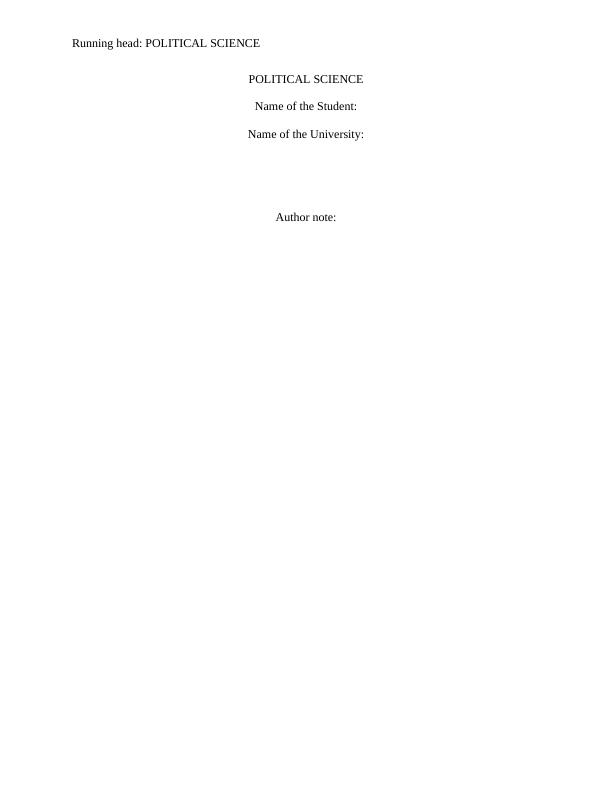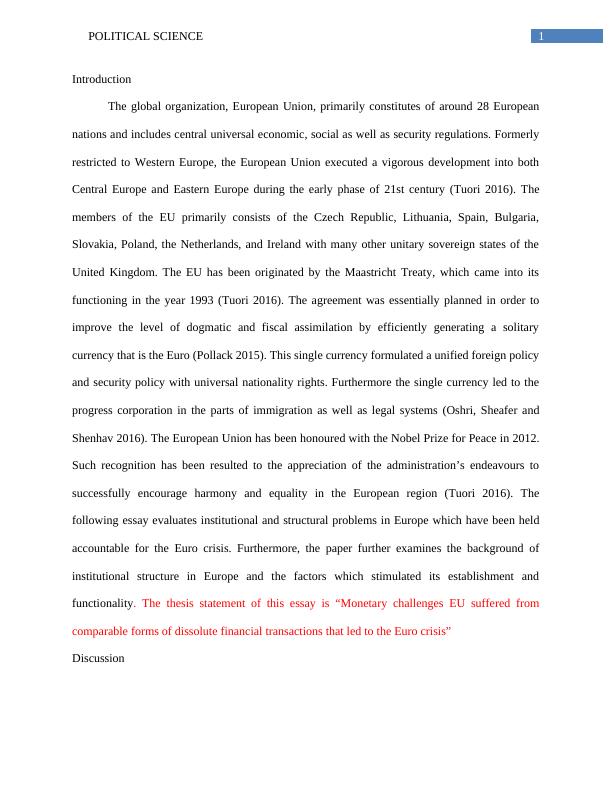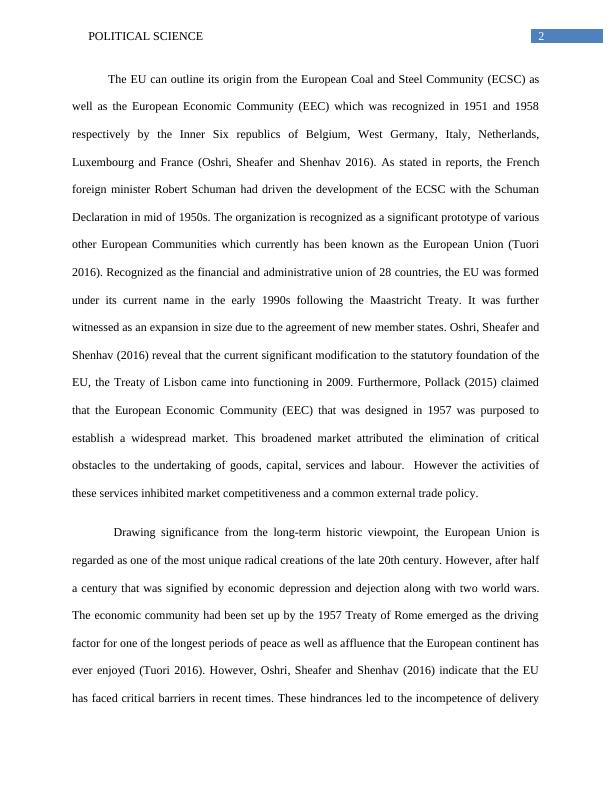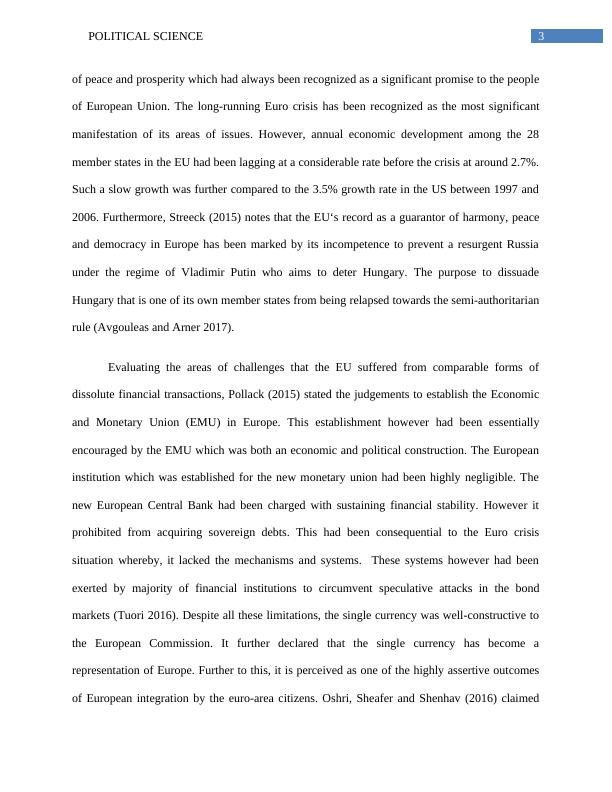Institutional and Structural Problems in Europe: Evaluating the Euro Crisis
Added on 2023-06-03
13 Pages3650 Words208 Views
Running head: POLITICAL SCIENCE
POLITICAL SCIENCE
Name of the Student:
Name of the University:
Author note:
POLITICAL SCIENCE
Name of the Student:
Name of the University:
Author note:

1POLITICAL SCIENCE
Introduction
The global organization, European Union, primarily constitutes of around 28 European
nations and includes central universal economic, social as well as security regulations. Formerly
restricted to Western Europe, the European Union executed a vigorous development into both
Central Europe and Eastern Europe during the early phase of 21st century (Tuori 2016). The
members of the EU primarily consists of the Czech Republic, Lithuania, Spain, Bulgaria,
Slovakia, Poland, the Netherlands, and Ireland with many other unitary sovereign states of the
United Kingdom. The EU has been originated by the Maastricht Treaty, which came into its
functioning in the year 1993 (Tuori 2016). The agreement was essentially planned in order to
improve the level of dogmatic and fiscal assimilation by efficiently generating a solitary
currency that is the Euro (Pollack 2015). This single currency formulated a unified foreign policy
and security policy with universal nationality rights. Furthermore the single currency led to the
progress corporation in the parts of immigration as well as legal systems (Oshri, Sheafer and
Shenhav 2016). The European Union has been honoured with the Nobel Prize for Peace in 2012.
Such recognition has been resulted to the appreciation of the administration’s endeavours to
successfully encourage harmony and equality in the European region (Tuori 2016). The
following essay evaluates institutional and structural problems in Europe which have been held
accountable for the Euro crisis. Furthermore, the paper further examines the background of
institutional structure in Europe and the factors which stimulated its establishment and
functionality. The thesis statement of this essay is “Monetary challenges EU suffered from
comparable forms of dissolute financial transactions that led to the Euro crisis”
Discussion
Introduction
The global organization, European Union, primarily constitutes of around 28 European
nations and includes central universal economic, social as well as security regulations. Formerly
restricted to Western Europe, the European Union executed a vigorous development into both
Central Europe and Eastern Europe during the early phase of 21st century (Tuori 2016). The
members of the EU primarily consists of the Czech Republic, Lithuania, Spain, Bulgaria,
Slovakia, Poland, the Netherlands, and Ireland with many other unitary sovereign states of the
United Kingdom. The EU has been originated by the Maastricht Treaty, which came into its
functioning in the year 1993 (Tuori 2016). The agreement was essentially planned in order to
improve the level of dogmatic and fiscal assimilation by efficiently generating a solitary
currency that is the Euro (Pollack 2015). This single currency formulated a unified foreign policy
and security policy with universal nationality rights. Furthermore the single currency led to the
progress corporation in the parts of immigration as well as legal systems (Oshri, Sheafer and
Shenhav 2016). The European Union has been honoured with the Nobel Prize for Peace in 2012.
Such recognition has been resulted to the appreciation of the administration’s endeavours to
successfully encourage harmony and equality in the European region (Tuori 2016). The
following essay evaluates institutional and structural problems in Europe which have been held
accountable for the Euro crisis. Furthermore, the paper further examines the background of
institutional structure in Europe and the factors which stimulated its establishment and
functionality. The thesis statement of this essay is “Monetary challenges EU suffered from
comparable forms of dissolute financial transactions that led to the Euro crisis”
Discussion

2POLITICAL SCIENCE
The EU can outline its origin from the European Coal and Steel Community (ECSC) as
well as the European Economic Community (EEC) which was recognized in 1951 and 1958
respectively by the Inner Six republics of Belgium, West Germany, Italy, Netherlands,
Luxembourg and France (Oshri, Sheafer and Shenhav 2016). As stated in reports, the French
foreign minister Robert Schuman had driven the development of the ECSC with the Schuman
Declaration in mid of 1950s. The organization is recognized as a significant prototype of various
other European Communities which currently has been known as the European Union (Tuori
2016). Recognized as the financial and administrative union of 28 countries, the EU was formed
under its current name in the early 1990s following the Maastricht Treaty. It was further
witnessed as an expansion in size due to the agreement of new member states. Oshri, Sheafer and
Shenhav (2016) reveal that the current significant modification to the statutory foundation of the
EU, the Treaty of Lisbon came into functioning in 2009. Furthermore, Pollack (2015) claimed
that the European Economic Community (EEC) that was designed in 1957 was purposed to
establish a widespread market. This broadened market attributed the elimination of critical
obstacles to the undertaking of goods, capital, services and labour. However the activities of
these services inhibited market competitiveness and a common external trade policy.
Drawing significance from the long-term historic viewpoint, the European Union is
regarded as one of the most unique radical creations of the late 20th century. However, after half
a century that was signified by economic depression and dejection along with two world wars.
The economic community had been set up by the 1957 Treaty of Rome emerged as the driving
factor for one of the longest periods of peace as well as affluence that the European continent has
ever enjoyed (Tuori 2016). However, Oshri, Sheafer and Shenhav (2016) indicate that the EU
has faced critical barriers in recent times. These hindrances led to the incompetence of delivery
The EU can outline its origin from the European Coal and Steel Community (ECSC) as
well as the European Economic Community (EEC) which was recognized in 1951 and 1958
respectively by the Inner Six republics of Belgium, West Germany, Italy, Netherlands,
Luxembourg and France (Oshri, Sheafer and Shenhav 2016). As stated in reports, the French
foreign minister Robert Schuman had driven the development of the ECSC with the Schuman
Declaration in mid of 1950s. The organization is recognized as a significant prototype of various
other European Communities which currently has been known as the European Union (Tuori
2016). Recognized as the financial and administrative union of 28 countries, the EU was formed
under its current name in the early 1990s following the Maastricht Treaty. It was further
witnessed as an expansion in size due to the agreement of new member states. Oshri, Sheafer and
Shenhav (2016) reveal that the current significant modification to the statutory foundation of the
EU, the Treaty of Lisbon came into functioning in 2009. Furthermore, Pollack (2015) claimed
that the European Economic Community (EEC) that was designed in 1957 was purposed to
establish a widespread market. This broadened market attributed the elimination of critical
obstacles to the undertaking of goods, capital, services and labour. However the activities of
these services inhibited market competitiveness and a common external trade policy.
Drawing significance from the long-term historic viewpoint, the European Union is
regarded as one of the most unique radical creations of the late 20th century. However, after half
a century that was signified by economic depression and dejection along with two world wars.
The economic community had been set up by the 1957 Treaty of Rome emerged as the driving
factor for one of the longest periods of peace as well as affluence that the European continent has
ever enjoyed (Tuori 2016). However, Oshri, Sheafer and Shenhav (2016) indicate that the EU
has faced critical barriers in recent times. These hindrances led to the incompetence of delivery

3POLITICAL SCIENCE
of peace and prosperity which had always been recognized as a significant promise to the people
of European Union. The long-running Euro crisis has been recognized as the most significant
manifestation of its areas of issues. However, annual economic development among the 28
member states in the EU had been lagging at a considerable rate before the crisis at around 2.7%.
Such a slow growth was further compared to the 3.5% growth rate in the US between 1997 and
2006. Furthermore, Streeck (2015) notes that the EU‘s record as a guarantor of harmony, peace
and democracy in Europe has been marked by its incompetence to prevent a resurgent Russia
under the regime of Vladimir Putin who aims to deter Hungary. The purpose to dissuade
Hungary that is one of its own member states from being relapsed towards the semi-authoritarian
rule (Avgouleas and Arner 2017).
Evaluating the areas of challenges that the EU suffered from comparable forms of
dissolute financial transactions, Pollack (2015) stated the judgements to establish the Economic
and Monetary Union (EMU) in Europe. This establishment however had been essentially
encouraged by the EMU which was both an economic and political construction. The European
institution which was established for the new monetary union had been highly negligible. The
new European Central Bank had been charged with sustaining financial stability. However it
prohibited from acquiring sovereign debts. This had been consequential to the Euro crisis
situation whereby, it lacked the mechanisms and systems. These systems however had been
exerted by majority of financial institutions to circumvent speculative attacks in the bond
markets (Tuori 2016). Despite all these limitations, the single currency was well-constructive to
the European Commission. It further declared that the single currency has become a
representation of Europe. Further to this, it is perceived as one of the highly assertive outcomes
of European integration by the euro-area citizens. Oshri, Sheafer and Shenhav (2016) claimed
of peace and prosperity which had always been recognized as a significant promise to the people
of European Union. The long-running Euro crisis has been recognized as the most significant
manifestation of its areas of issues. However, annual economic development among the 28
member states in the EU had been lagging at a considerable rate before the crisis at around 2.7%.
Such a slow growth was further compared to the 3.5% growth rate in the US between 1997 and
2006. Furthermore, Streeck (2015) notes that the EU‘s record as a guarantor of harmony, peace
and democracy in Europe has been marked by its incompetence to prevent a resurgent Russia
under the regime of Vladimir Putin who aims to deter Hungary. The purpose to dissuade
Hungary that is one of its own member states from being relapsed towards the semi-authoritarian
rule (Avgouleas and Arner 2017).
Evaluating the areas of challenges that the EU suffered from comparable forms of
dissolute financial transactions, Pollack (2015) stated the judgements to establish the Economic
and Monetary Union (EMU) in Europe. This establishment however had been essentially
encouraged by the EMU which was both an economic and political construction. The European
institution which was established for the new monetary union had been highly negligible. The
new European Central Bank had been charged with sustaining financial stability. However it
prohibited from acquiring sovereign debts. This had been consequential to the Euro crisis
situation whereby, it lacked the mechanisms and systems. These systems however had been
exerted by majority of financial institutions to circumvent speculative attacks in the bond
markets (Tuori 2016). Despite all these limitations, the single currency was well-constructive to
the European Commission. It further declared that the single currency has become a
representation of Europe. Further to this, it is perceived as one of the highly assertive outcomes
of European integration by the euro-area citizens. Oshri, Sheafer and Shenhav (2016) claimed

End of preview
Want to access all the pages? Upload your documents or become a member.
Related Documents
Brexit: Impact on UK and EU Economylg...
|8
|2538
|51
Treaty of Maastricht on European Union - PDFlg...
|13
|4060
|168
Economy of Europe - Assignmentlg...
|18
|3971
|333
Brexit's Impact on Taxi Services in Plymouth: A Literature Reviewlg...
|36
|13950
|77
Evolution and Structure of European Unionlg...
|5
|1092
|26
Business Issues in the Contemporary Worldlg...
|6
|1846
|21
